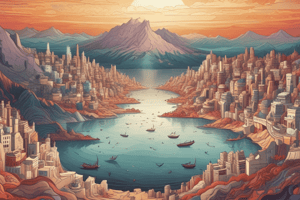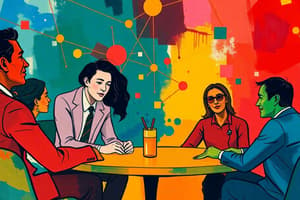Podcast
Questions and Answers
What is the primary role of the bureaucracy in the policy-making process?
What is the primary role of the bureaucracy in the policy-making process?
- To create laws and approve policies
- To carry out day-to-day implementation of policies (correct)
- To represent specific interests and influence policy decisions
- To implement policies and enforce laws
Which policy-making model involves a gradual and piecemeal approach, making small changes to existing policies?
Which policy-making model involves a gradual and piecemeal approach, making small changes to existing policies?
- Cost-Benefit Analysis
- Incremental Model (correct)
- Mixed Scanning Model
- Rational Model
What is the primary purpose of policy evaluation?
What is the primary purpose of policy evaluation?
- To identify a social problem or issue
- To implement the policy through laws and regulations
- To assess the effectiveness and impact of the policy (correct)
- To generate alternative solutions to address the problem
Which of the following is NOT a key actor in the policy-making process?
Which of the following is NOT a key actor in the policy-making process?
What type of analysis evaluates the costs and benefits of a policy to determine its effectiveness?
What type of analysis evaluates the costs and benefits of a policy to determine its effectiveness?
What is the primary purpose of the initiation step in the legislative process for cultural affairs?
What is the primary purpose of the initiation step in the legislative process for cultural affairs?
What is the main goal of cultural policy in cultural affairs legislation?
What is the main goal of cultural policy in cultural affairs legislation?
What occurs during the mark-up stage of the committee review process?
What occurs during the mark-up stage of the committee review process?
What is the role of the executive branch in the legislative process for cultural affairs?
What is the role of the executive branch in the legislative process for cultural affairs?
What is the primary focus of heritage preservation in cultural affairs legislation?
What is the primary focus of heritage preservation in cultural affairs legislation?
Flashcards are hidden until you start studying
Study Notes
Policy Making
Definition
- Policy making is the process of creating, implementing, and evaluating public policies by governments to address social, economic, and political issues.
Steps in Policy Making
- Problem Identification: Identifying a social problem or issue that requires government attention.
- Policy Formulation: Generating alternative solutions to address the problem.
- Policy Adoption: Selecting a particular solution and adopting it as a policy.
- Policy Implementation: Putting the policy into action through laws, regulations, and programs.
- Policy Evaluation: Assessing the effectiveness and impact of the policy.
Key Actors in Policy Making
- Legislature: Creates laws and approves policies.
- Executive: Implements policies and enforces laws.
- Bureaucracy: Carries out day-to-day implementation of policies.
- Interest Groups: Representing specific interests and influencing policy decisions.
- Citizens: Participating in the policy-making process through voting, advocacy, and public opinion.
Policy Making Models
- Rational Model: A systematic and objective approach to policy making, considering all options and evaluating their consequences.
- Incremental Model: A gradual and piecemeal approach, making small changes to existing policies.
- Mixed Scanning Model: A combination of rational and incremental approaches, considering both broad goals and incremental changes.
Policy Analysis
- Cost-Benefit Analysis: Evaluating the costs and benefits of a policy to determine its effectiveness.
- Impact Analysis: Assessing the potential impacts of a policy on different groups and stakeholders.
- SWOT Analysis: Identifying the strengths, weaknesses, opportunities, and threats associated with a policy.
Policy Making
Definition
- Policy making is a process governments use to create, implement, and evaluate public policies to address social, economic, and political issues.
Steps in Policy Making
- Problem identification is the first step, where governments identify a social problem or issue that needs attention.
- Policy formulation involves generating alternative solutions to address the problem.
- In policy adoption, a particular solution is selected and adopted as a policy.
- Policy implementation puts the policy into action through laws, regulations, and programs.
- Policy evaluation assesses the effectiveness and impact of the policy.
Key Actors in Policy Making
- The legislature creates laws and approves policies.
- The executive implements policies and enforces laws.
- Bureaucracy carries out day-to-day implementation of policies.
- Interest groups represent specific interests and influence policy decisions.
- Citizens participate in the policy-making process through voting, advocacy, and public opinion.
Policy Making Models
- The rational model is a systematic and objective approach, considering all options and evaluating their consequences.
- The incremental model is a gradual and piecemeal approach, making small changes to existing policies.
- The mixed scanning model combines rational and incremental approaches, considering both broad goals and incremental changes.
Policy Analysis
- Cost-benefit analysis evaluates the costs and benefits of a policy to determine its effectiveness.
- Impact analysis assesses the potential impacts of a policy on different groups and stakeholders.
- SWOT analysis identifies the strengths, weaknesses, opportunities, and threats associated with a policy.
Legislative Process: Cultural Affairs
Definition and Scope
- Cultural affairs involve government policies and legislation related to arts, culture, and heritage.
Steps in the Legislative Process for Cultural Affairs
- Proposals for cultural affairs legislation come from government agencies, advocacy groups, or individuals.
- Bills are drafted to outline policy changes or funding allocations for cultural programs.
- The bill is introduced to the legislature, formally read, and referred to a committee.
Committee Review
- Public hearings are held to gather input from experts, stakeholders, and the general public.
- The committee reviews, amends, and revises the bill based on input received.
Floor Debate and Vote
- The bill is debated on the floor of the legislature, where members discuss and argue for or against the bill.
- The bill is put to a vote, and if it passes, it is sent to the next chamber or to the executive branch for signing.
Executive Branch Involvement
- The executive branch reviews the bill and decides whether to sign it into law or veto it.
- If signed, the executive branch is responsible for implementing the new law, allocating funds, or creating new programs.
Key Concepts in Cultural Affairs Legislation
- Cultural policy refers to a set of principles and goals guiding government decisions on cultural development and preservation.
- Arts funding involves government allocations for supporting arts programs, institutions, and initiatives.
- Heritage preservation efforts protect and conserve cultural and historical sites, artifacts, and traditions.
Examples of Cultural Affairs Legislation
- The National Endowment for the Arts (NEA) receives annual funding for supporting arts programs and initiatives across the country.
- The Historic Preservation Act protects and preserves historical sites, buildings, and landmarks.
- Cultural Exchange Programs promote international collaboration and exchange in the arts, education, and cultural heritage.
Studying That Suits You
Use AI to generate personalized quizzes and flashcards to suit your learning preferences.




